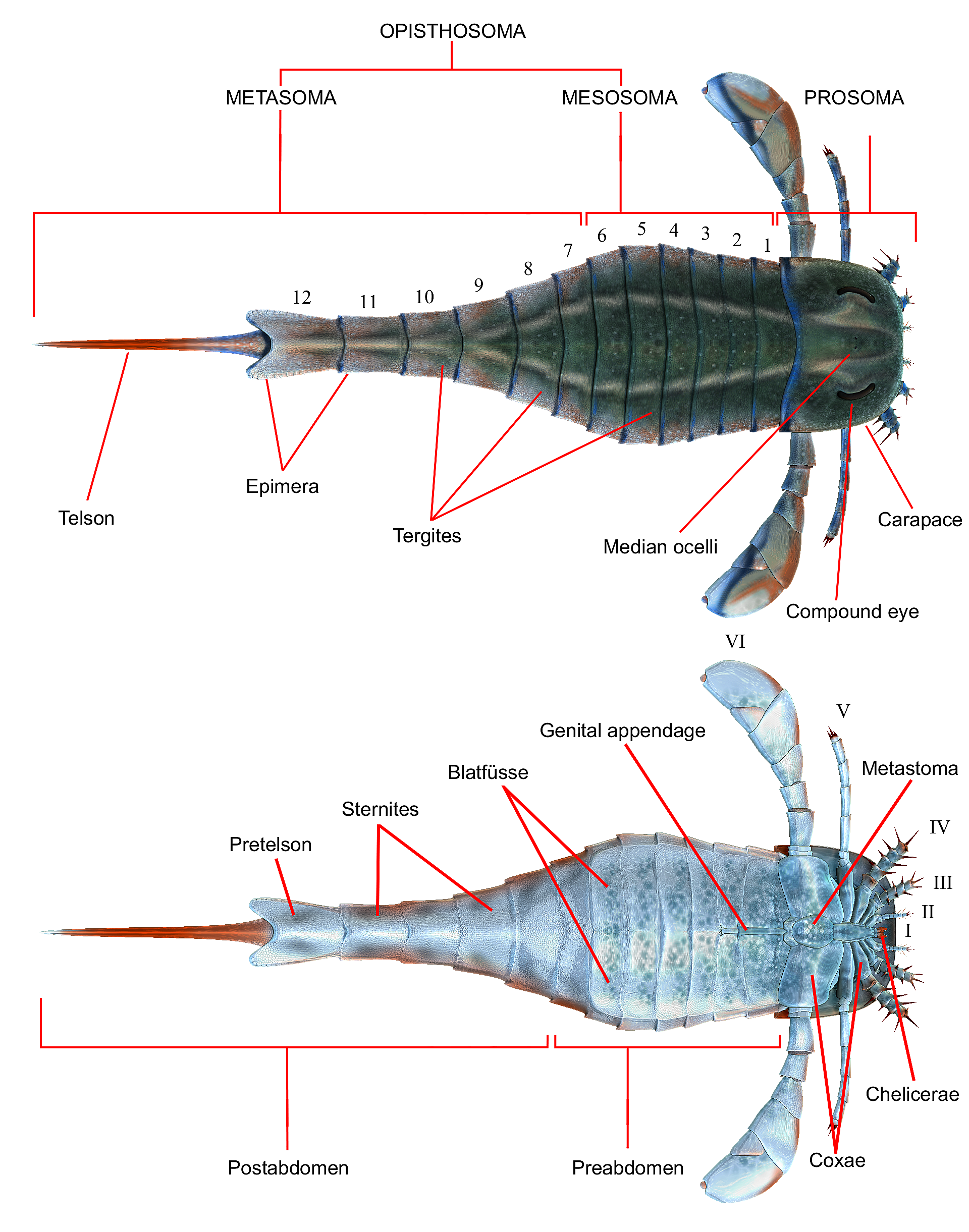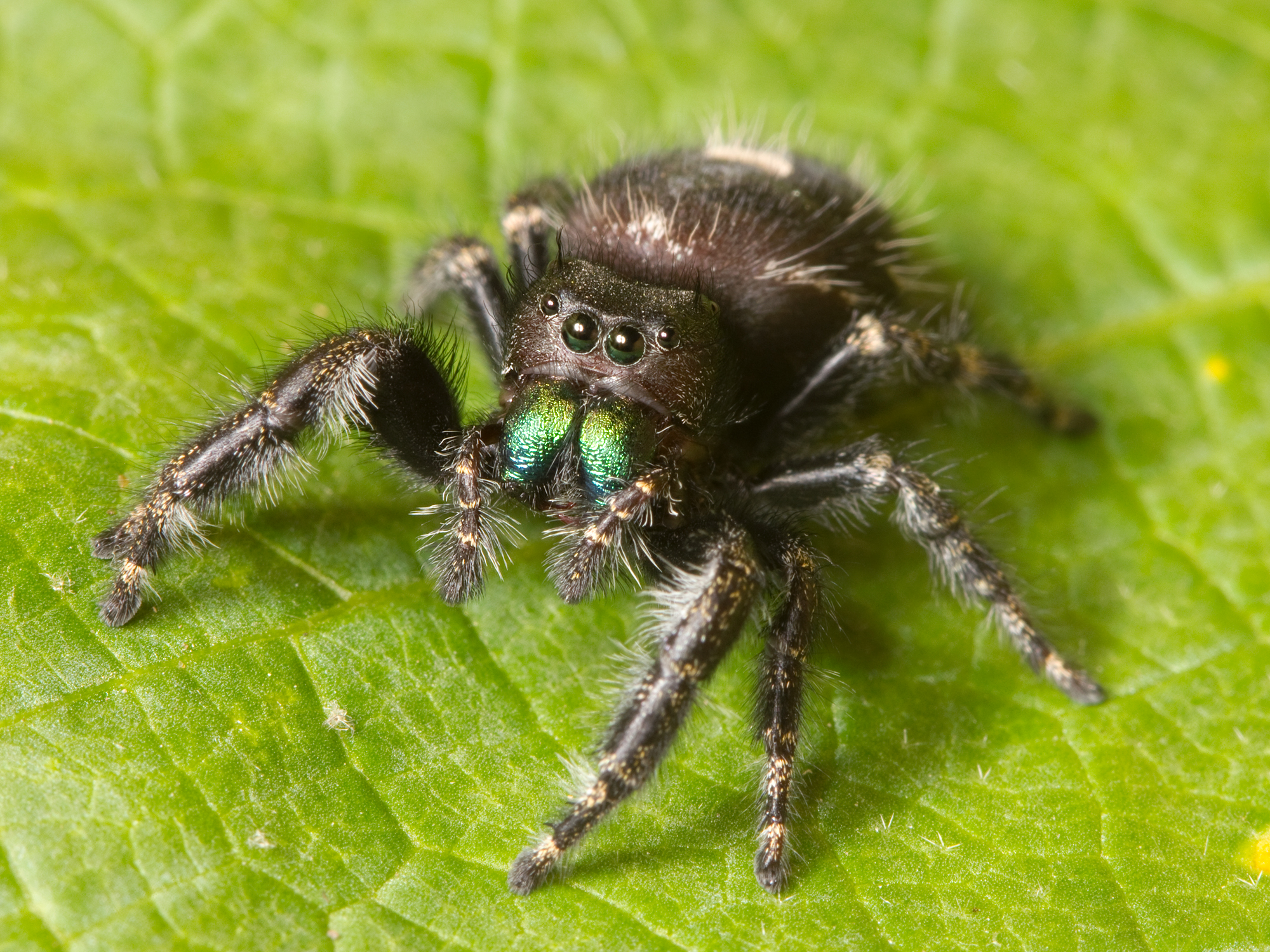|
Xiphosura
Xiphosura () is an order of arthropods related to arachnids. They are more commonly known as horseshoe crabs (a name applied more specifically to the only extant family, Limulidae). They first appeared in the Hirnantian (Late Ordovician). Currently, there are only four living species. Xiphosura contains one suborder, Xiphosurida, and several stem-genera. The group has hardly changed in appearance in hundreds of millions of years; the modern horseshoe crabs look almost identical to prehistoric genera and are considered to be living fossils. The most notable difference between ancient and modern forms is that the abdominal segments in present species are fused into a single unit in adults. Xiphosura were historically placed in the class Merostomata, although this term was intended to encompass also the eurypterids, whence it denoted what is now known to be an unnatural (paraphyletic) group (although this is a grouping recovered in some recent cladistic analyses). Although the name ... [...More Info...] [...Related Items...] OR: [Wikipedia] [Google] [Baidu] |
Horseshoe Crab
Horseshoe crabs are marine and brackish water arthropods of the family Limulidae and the only living members of the order Xiphosura. Despite their name, they are not true crabs or crustaceans: they are Chelicerata, chelicerates, most closely related to arachnids, such as spiders and scorpions. Horseshoe crabs live primarily in and around shallow coastal waters on soft, sandy or muddy bottoms. They are generally found in the intertidal zone at spring tide, spring high tides. They are eaten in some parts of Asia, and used as fishing bait, in fertilizer and in science (especially Limulus amebocyte lysate, ''Limulus'' amebocyte lysate). In recent years, population declines have occurred as a consequence of coastal habitat destruction and overharvesting. Tetrodotoxin may be present in one horseshoe crab species, ''Carcinoscorpius rotundicauda''. Fossil records for horseshoe crabs extend back as far as 480 million years ago, with extant forms being living fossils. A 2019 molecular anal ... [...More Info...] [...Related Items...] OR: [Wikipedia] [Google] [Baidu] |
Atlantic Horseshoe Crab
The Atlantic horseshoe crab (''Limulus polyphemus''), also known as the American horseshoe crab, is a species of marine biology, marine and Brackish water, brackish chelicerate arthropod. Despite their name, horseshoe crabs are more closely related to spiders, ticks, and scorpions than to crabs. It is found in the Gulf of Mexico and along the Atlantic coast of North America. The main area of annual Animal migration, migration is Delaware Bay along the South Jersey Delaware Bayshore. Their eggs were eaten by Indigenous peoples of the Americas, Native Americans, but today Atlantic horseshoe crabs are caught for use as fishing bait, in biomedicine (especially for Limulus amebocyte lysate, ''Limulus'' amebocyte lysate) and science. They play a major role in the local ecosystems, with their eggs providing an important food source for shorebirds, and the juveniles and adults being eaten by sea turtles. The other three Extant taxon, extant (living) species in the family Limulidae are al ... [...More Info...] [...Related Items...] OR: [Wikipedia] [Google] [Baidu] |
Arachnid
Arachnida () is a class of joint-legged invertebrate animals ( arthropods), in the subphylum Chelicerata. Arachnida includes, among others, spiders, scorpions, ticks, mites, pseudoscorpions, harvestmen, camel spiders, whip spiders and vinegaroons. Almost all adult arachnids have eight legs, although the front pair of legs in some species has converted to a sensory function, while in other species, different appendages can grow large enough to take on the appearance of extra pairs of legs. The term is derived from the Greek word (''aráchnē'', 'spider'), from the myth of the hubristic human weaver Arachne, who was turned into a spider. Almost all extant arachnids are terrestrial, living mainly on land. However, some inhabit freshwater environments and, with the exception of the pelagic zone, marine environments as well. They comprise over 100,000 named species, of which 47,000 are species of spiders. Morphology Almost all adult arachnids have eight legs, unli ... [...More Info...] [...Related Items...] OR: [Wikipedia] [Google] [Baidu] |
Eurypterida
Eurypterids, often informally called sea scorpions, are a group of extinct arthropods that form the order Eurypterida. The earliest known eurypterids date to the Darriwilian stage of the Ordovician period 467.3 million years ago. The group is likely to have appeared first either during the Early Ordovician or Late Cambrian period. With approximately 250 species, the Eurypterida is the most diverse Paleozoic chelicerate order. Following their appearance during the Ordovician, eurypterids became major components of marine faunas during the Silurian, from which the majority of eurypterid species have been described. The Silurian genus '' Eurypterus'' accounts for more than 90% of all known eurypterid specimens. Though the group continued to diversify during the subsequent Devonian period, the eurypterids were heavily affected by the Late Devonian extinction event. They declined in numbers and diversity until becoming extinct during the Permian–Triassic extinction event (or somet ... [...More Info...] [...Related Items...] OR: [Wikipedia] [Google] [Baidu] |
Willwerathia
''Willwerathia'' is a genus of synziphosurine, a paraphyletic group of horseshoe crab-like fossil chelicerate arthropods. ''Willwerathia'' known only by one species, ''Willwerathia laticeps'', discovered in deposits of the Devonian period from the Klerf Formation, in the Rhenish Slate Mountains of Germany. Morphology As a synziphosurine, ''Willwerathia'' is unusually large and so far the largest known synziphosurine, with largest carapace measured about 90mm in width. Prosoma of ''Willwerathia'' covered by a vaulted carapace with pointed genal spines, recurved (M-shaped) ophthalmic ridges and pairs of dorsal nodes. Tergites of the opisthosoma are either incomplete or disarticulated in available fossil materials, making it difficult to reveal the original number of opisthosomal segments. The opisthosoma of ''Willwerathia'' most likely compose of 10 segments, each expressed by a tergite that bore a median dorsal spine and a pair of tergopleurae (lateral extensions). The opi ... [...More Info...] [...Related Items...] OR: [Wikipedia] [Google] [Baidu] |
Arthropod
Arthropods (, (gen. ποδός)) are invertebrate animals with an exoskeleton, a Segmentation (biology), segmented body, and paired jointed appendages. Arthropods form the phylum Arthropoda. They are distinguished by their jointed limbs and Arthropod cuticle, cuticle made of chitin, often Mineralization (biology), mineralised with calcium carbonate. The arthropod body plan consists of segments, each with a pair of appendages. Arthropods are bilaterally symmetrical and their body possesses an exoskeleton, external skeleton. In order to keep growing, they must go through stages of moulting, a process by which they shed their exoskeleton to reveal a new one. Some species have wings. They are an extremely diverse group, with up to 10 million species. The haemocoel, an arthropod's internal cavity, through which its haemolymph – analogue of blood – circulates, accommodates its interior Organ (anatomy), organs; it has an open circulatory system. Like their exteriors, the internal or ... [...More Info...] [...Related Items...] OR: [Wikipedia] [Google] [Baidu] |
Ricinulei
Ricinulei is a small order of arachnids. Like most arachnids, they are predatory, eating small arthropods. They occur today in west-central Africa ('' Ricinoides'') and the Neotropics ('' Cryptocellus'' and '' Pseudocellus'') as far north as Texas. As of 2021, 91 extant species of ricinuleids have been described worldwide, all in the single family Ricinoididae. In older works they are sometimes referred to as Podogona. Due to their obscurity they do not have a proper common name, though in academic literature they are occasionally referred to as hooded tickspiders. In addition to the three living genera, there are fossil species from the upper Carboniferous of Euramerica and the Cretaceous Burmese amber. Description The most important general account of ricinuleid anatomy remains the 1904 monograph by Hans Jacob Hansen and William Sørensen. Useful further studies can be found in, e.g., the work of Pittard and Mitchell, Gerald Legg and L. van der Hammen. Body Ricinulei are t ... [...More Info...] [...Related Items...] OR: [Wikipedia] [Google] [Baidu] |
Maldybulakia
''Maldybulakia'' is a genus of freshwater arthropod which lived during the Devonian period. ''Maldybulakia'' is known from three species, ''M. angusi'' and ''M. malcolmi'' from Australia, and ''M. mirabilis'' from Kazakhstan. Although it was originally described as a myriapod-like animal, it was later considered related to the xiphosurans, a group including modern horseshoe crabs. Discovery and etymology In 1992, the type species of ''Maldybulakia'' is described from the Pragian to Emsian-aged Sheshen'karinskaya Formation (also known as the Sheshenkarinskoy Suite) in central Kazakhstan, with scientific name ''Lophodesmus mirabilis''. The genus name ''Lophodesmus'' came from the Greek ''lophos'' ("tubercle") and ''desmos'' ("bond"), and the species name ''mirabilis'' means "wonderful" in Latin. However, this genus name is already used for an extant genus of myriapod, and in 1998, the new genus name ''Maldybulakia'', named after Maldybulak Farm in the Bayanaul Distri ... [...More Info...] [...Related Items...] OR: [Wikipedia] [Google] [Baidu] |
Living Fossil
A living fossil is an extant taxon that cosmetically resembles related species known only from the fossil record. To be considered a living fossil, the fossil species must be old relative to the time of origin of the extant clade. Living fossils commonly are of species-poor lineages, but they need not be. While the body plan of a living fossil remains superficially similar, it is never the same species as the remote relatives it resembles, because genetic drift would inevitably change its chromosomal structure. Living fossils exhibit stasis (also called "bradytely") over geologically long time scales. Popular literature may wrongly claim that a "living fossil" has undergone no significant evolution since fossil times, with practically no molecular evolution or morphological changes. Scientific investigations have repeatedly discredited such claims. The minimal superficial changes to living fossils are mistakenly declared as an absence of evolution, but they are examples of ... [...More Info...] [...Related Items...] OR: [Wikipedia] [Google] [Baidu] |
Lunataspis
''Lunataspis'' is the oldest known xiphosuran. It was first formally described by David Rudkin, Graham Young and Godfrey Nolan, from fossils found in northern Manitoba, Canada in 2005; the deposit dates from the Late Ordovician, .Chliboyko, J. ''Crabby Ancestors'', Canadian Geographic Magazine, April 2008, p. 25 Discovery and species The type species, ''L. aurora'', was described from remains found in the Konservat-Lagerstätten deposits of the Stony Mountain Formation, central Manitoba. The specific name ''aurora'' is Latin for 'dawn' and is also eponymous with the mythological Roman goddess. A second species, ''L. borealis'', was described in 2022 based on three specimens, including an adult ( ROM IP 64616) and two juveniles or subadults ( ROM IP 64617 and ROM IP 64618). All specimens were found in the upper member of the Gull River Formation in Kingston, Ontario. See also * 2005 in paleontology * 2008 in paleontology * List of xiphosurans This list of xiphosurans is ... [...More Info...] [...Related Items...] OR: [Wikipedia] [Google] [Baidu] |
Chelicera
The chelicerae () are the mouthparts of the subphylum Chelicerata, an arthropod group that includes arachnids, horseshoe crabs, and sea spiders. Commonly referred to as " jaws", chelicerae may be shaped as either articulated fangs, or similarly to pincers. Some chelicerae, such as those found on nearly all spiders, are hollow and contain (or are connected to) venom glands, and are used to inject venom into prey or a perceived threat. In '' Pisaurina mira'', also known as the nursery web spider, the chelicerae are utilized to snatch the prey once it becomes within reach, facilitating the "sit-and-wait ambush predator" behavior. Both pseudoscorpions and harvestmen have structures on their chelicerae that are used for grooming (papillae in pseudoscorpions, cheliceral teeth in Opiliones). Types Chelicerae can be divided into three kinds: jackknife chelicerae, scissor chelicerae, and 3-segmented chelate chelicerae. Jackknife chelicerae The jackknife chelicera is subchelate (wit ... [...More Info...] [...Related Items...] OR: [Wikipedia] [Google] [Baidu] |





_(cropped).jpg)

